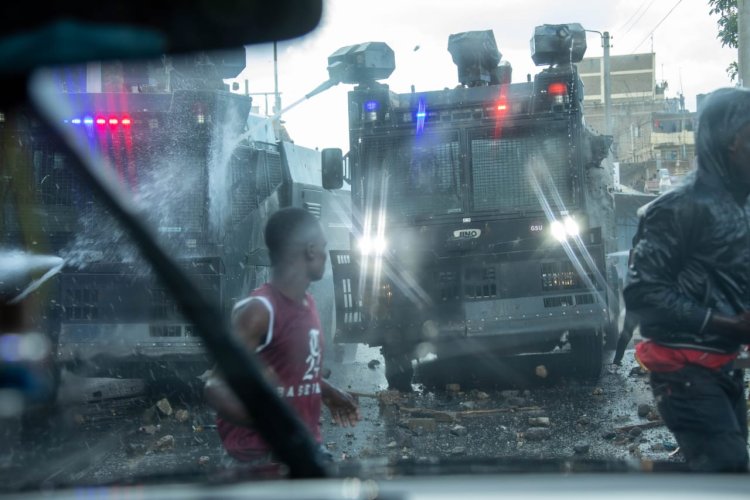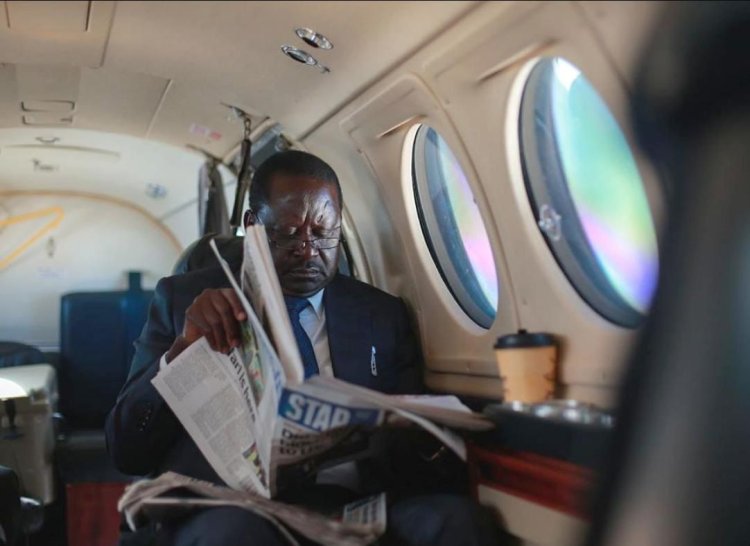Raila Protests: Chiloba Threatens To Shut Down NTV, Citizen TV, KTN & 3 TV Stations
The CA had completed a review of the Broadcast Coverage of the Azimio demonstrations held on March 20...

Communication Authority of Kenya (CA) Director General Ezra Chiloba has threatened to withdraw the licenses of six (6) local TV stations over the coverage of the Azimio la Umoja mass protests on Monday, March 20.
In a statement on Wednesday, March 22, Chiloba singled out Citizen TV, NTV, K24, national broadcaster KBC, TV47 and Ebru TV, accusing them of violating the Programming Code during their live coverage of the Azimio protests majorly in Nairobi and Kisumu.
The CA had completed a review of the Broadcast Coverage of the Azimio demonstrations held on March 20 and accused the six TV stations of covering the protests in a manner that violated its regulations.

A photo of some of the police water cannon trucks used on March 20, 2023, mounted on a police water cannon truck. /RAILA ODINGA
"The coverage depicted scenes that could cause panic or incitement to the public, threatening peace and cohesion in the country.
"The Authority has, in accordance with the relevant provisions of the law, issued notices to the identified broadcasters to take immediate remedial actions," stated CA in part.
Chiloba used the statement issued in the late evening hours to remind all broadcasters of the regulator's obligations as outlined below:
- Section 33 of the Constitution of Kenya as read together with Section 5B of the Kenya Information and Communication Act, which provide that the constitutionally guaranteed right to Freedom of Expression, does not extend to propaganda for war, incitement to violence, hate speech or advocacy of hatred that constitutes ethnic incitement, vilification of others, or incitement to cause harm or discrimination;
- Clauses 461 (1) (a) Kenya Information and Communications Act which requires licensed broadcasters to provide responsible and responsive programming that caters for the varied needs and susceptibilities of different sections of the Kenyan community;
- Clauses 19 (1) (c) and (d) Kenya Information and Communications (Broadcasting) Regulations which require a licensee to ensure that no broadcasts by its station "glorifies violence or depicts violence in an offensive manner; or is likely to incite, perpetuate hatred, vilify any person or section of the community;
- Clause 10.2.1 of the Programming Code which requires broadcasters to take care in coverage of crisis situations so as not to hinder or obstruct efforts by authorities to resolve the situation;
- Section 5.8.4 of the Programming Code which states that the presentation of news and commentaries must not be done in a way that would create unnecessary panic or alarm;
- Section 5.8.3 of the Programming Code which states that morbid, violent, sensational or alarming details that are not essential to factual reporting are not permissible; and
- Clause 2.4 of the Programming Code which states that broadcasters are responsible for the broadcast materials relayed on their stations, regardless of their source, as well as the professional activities of its employees.
"While the Authority promotes freedom of the press, it is imperative that all broadcasters exercise caution in Live Broadcast Coverage in order to avoid scenes that would be detrimental to peace and cohesion," he added.
Amidst the now bi-weekly demonstrations set for Monday, March 27 and Thursday, March 30, Chiloba vowed to take action against any broadcaster that violates the rules by threatening to revoke their broadcast licences.
"Take notice that failure to adhere to the outlined obligations shall be acting in breach of licence conditions, which shall attract liability under relevant provisions of the law, including revocation of broadcast licence and/or broadcast frequencies," he went on.
Monday's mass action called by Azimio leader Raila Odinga was marred by ugly scenes where protesters were filmed engaging police officers in running battles. Photos and video clips doing rounds online showed some armed police officers climbing over perimeter walls with protesters in hot pursuit.
The protests, the first for the Azimio coalition, turned chaotic as a total of 31 police officers were injured and 238 protesters were arrested, according to Inspector General of Police Japhet Koome.
Chiloba's statement is likely to intensify a bitter row between government officials together with opposition politicians against the Kenyan media, which was ignited by Raila when he ordered his supporters on Tuesday, March 21 to boycott several products and services, including Radio Africa Group's The Star Newspaper.
The Media Council of Kenya (MCK), the Kenya Editors' Guild (KEG), the Kenya Union of Journalists (KUJ), the Political Journalists Association of Kenya (PJAK) and Radio Africa all hit back at Raila's comments which singled out the daily newspaper as among corporates that "have become enablers and facilitators of this brutal regime" and have as such "become the enemies of the people", despite earlier commending the media for its coverage of the March 20 protests.


 admin
admin 




